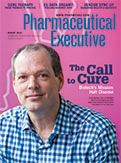FDA Faces ‘Explosion’ in Growth of Gene Therapies
Pharmaceutical Executive
Agency focused on advancing testing and production methods, seeking input from other regions on common approaches.
The recent approval of Novartis’s $2 million gene therapy Zolgensma, a one-shot cure that can prevent the death of infants from spinal muscular atrophy, reflects the emergence of a new world of effective treatments for critical conditions. Innovative therapies can replace, repair or inactivate a gene, either through direct administration of the product to the patient or by taking cells from the body, modifying them in culture, and
Jill Wechsler

returning them to the patient. Amidst some notable successes are many failed efforts, as scientists and innovators strive to advance novel technologies, while regulators adjust policies and practices to support these efforts. FDA officials are ramping up guidance development, streamlining oversight, and taking steps to advance manufacturing and clinical development of these cutting-edge treatments.
FDA’s Center for Biologics Evaluation and Research (CBER) has seen an “explosion” of growth in the cellular and gene therapy area, observed CBER deputy director Celia Witten at the Cell & Gene Therapy Products Symposium sponsored in June by CASSS. CBER’s Office of Tissues and Advanced Therapies (OTAT) received more than 400 investigational new drug applications (INDs) in 2018, many qualifying for breakthrough therapy status and the Regenerative Medicine Advanced Therapies (RMATs) designation for products providing evidence of treating, modifying, or curing a serious or life-threatening condition. For such therapies, FDA offers sponsors extra assistance in developing innovative testing and production methods, expedited review, and flexibility in meeting regulatory requirements.
FDA also is collaborating with regulators in other regions to devise common approaches and policies for developing and testing these innovative therapies around the world. The Cell Therapy Working Group of the International Pharmaceutical Regulators Programme (IPRP) has finalized a reflection paper on the nature and duration of clinical trials using cell therapies. And a paper from the IPRP Gene Therapy Working Group discusses expectations for biodistribution assessments for gene therapy products. This analysis may provide a basis for the International Council for Harmonization (ICH) to develop a guideline on biodistribution studies of gene therapy vectors.
To further advance standards for product development and assessment in this area, FDA is working with the National Institute for Standards & Technology (NIST) and has a contract with the Nexight Group to coordinate these efforts.
Early assistance
To discuss proposals for untraditional development programs for cellular and gene therapies, CBER officials encourage sponsors to utilize its INTERACT program (INitial Targeted Engagement for Regulatory Advice on CBER producTs). This replaces pre-pre-IND interactions and offers early-stage informal consultation on product development, particularly for innovative devices, cutting-edge testing methodologies, and complex or novel manufacturing technologies. Such early discussion provides nonbinding advice and doesn’t replace the recommended pre-IND meeting for products further along the development pathway.
Manufacturers designing innovative production or development programs can gain additional advice and input from the CBER Advanced Technologies Team (CATT), recently formed to discuss and respond to queries from industry on advanced manufacturing and testing technologies. Initial inquiries to CATT should briefly describe the technology, why it is novel and unique, its potential impact on product

quality, and a summary of the manufacturing or development plan.
Expedited development and approval of cellular and gene therapies creates unique regulatory challenges and requires a “new paradigm,” said Steven Oh, deputy director of OTAT’s Division of Cellular and Gene Therapies, at the CASSS symposium. While these products still must meet quality standards, CBER officials emphasize that they will exercise some flexibility on the type and extent of manufacturing information expected in a submission. Such leeway will depend on product characteristics, the seriousness of the condition being treated, the type of manufacturing process, the robustness of a quality system, and the strength of the risk-based quality assessment. And regulatory flexibility usually will be linked to agreement on postmarketing commitments and requirements.
These strategies for establishing appropriate and efficient pathways for bringing innovative drugs to patients so far have involved treatments for single-gene disorders that generally affect very small patient populations. The challenges will increase exponentially as developers seek products with multigenic targets that stand to involve millions of patients. Programs will need new approaches for clinical trials and for production scale-up, and prices will be scrutinized even more to ensure patient access to therapy.
Jill Wechsler is Pharmaceutical Executive’s Washington Correspondent. She can be reached at jillwechsler7@gmail.com

Addressing Disparities in Psoriasis Trials: Takeda's Strategies for Inclusivity in Clinical Research
April 14th 2025LaShell Robinson, Head of Global Feasibility and Trial Equity at Takeda, speaks about the company's strategies to engage patients in underrepresented populations in its phase III psoriasis trials.